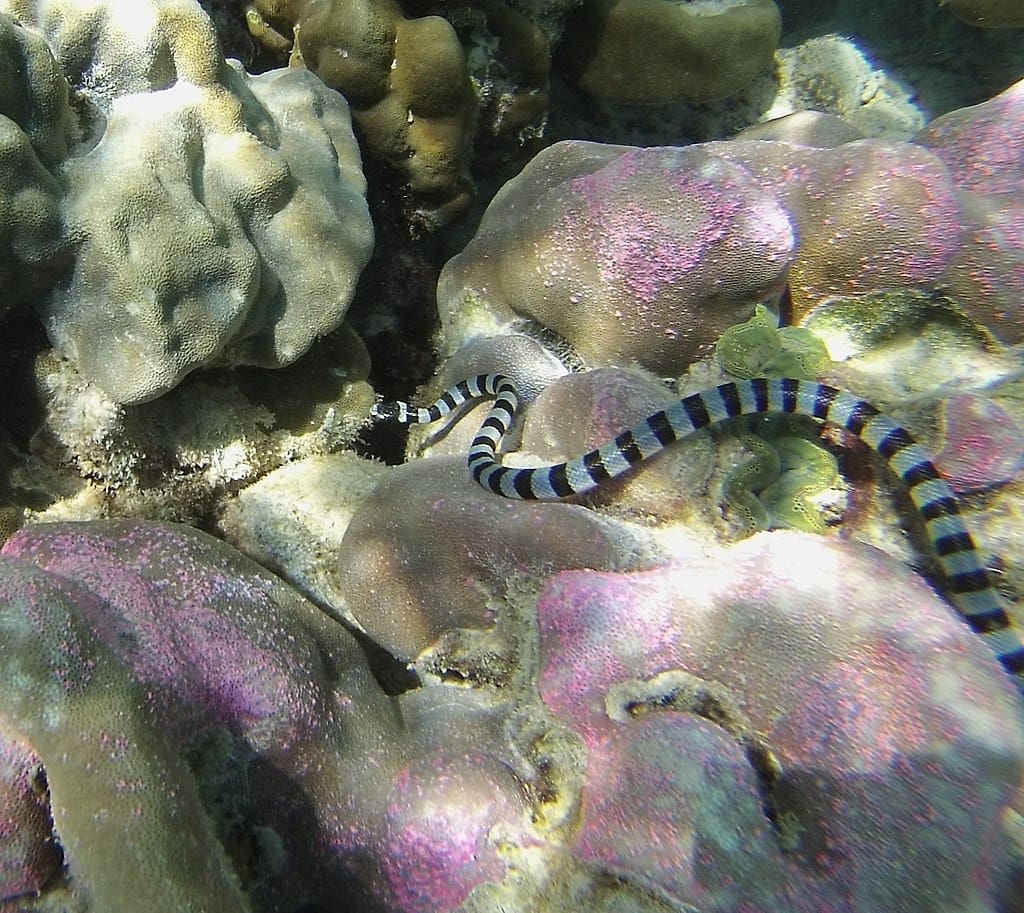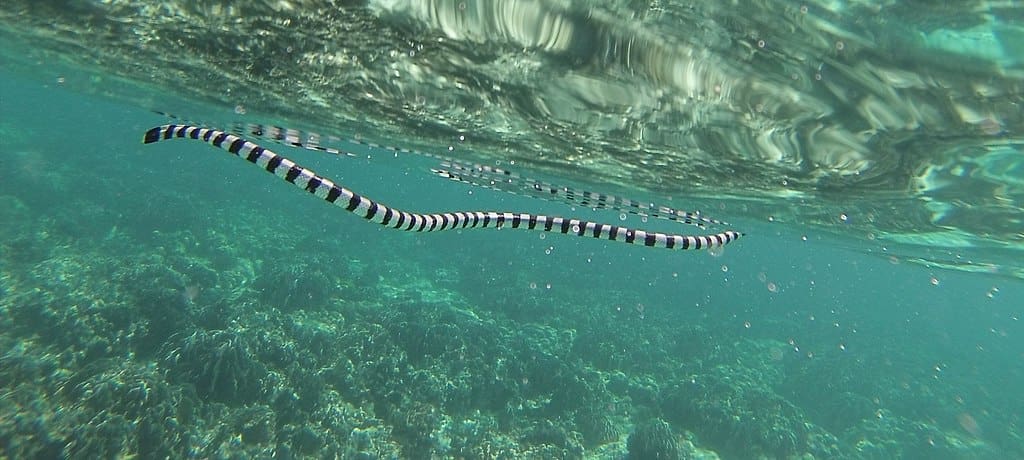What semiaquatic creature has a paddle-like tail, swims through crevices, and can even climb trees?
The banded sea krait!

Did you know that some snakes can swim? Beyond the legends of mighty and fearsome sea serpents, sea snakes exist, and swim through waters around the world, not just the pages of myth and folklore.
The banded sea krait is a type of sea snake that inhabits the Pacific and Indian Oceans. Males are about 30 inches long, while females can be up to 50 inches long. As the name may hint, the banded sea krait’s bluish-gray body is scored by thick, dark blue bands numbering from 20 to 65. The top half of its body is colored more darkly than its underside, a kind of pigmentation called countershading unique to many sea creatures. Countershading is a type of aquatic camouflage that helps the sea krait blend in with its environment, an adaptation that contributes to these creatures’ survival.
By appearing dark from above, the sea krait becomes challenging to differentiate from the water. By appearing lighter from below, it melds with the sunlight of shallow water. This makes it difficult for predatory birds to spot the sea krait from the sky and conceals the reptile from prey watching below.
The banded sea krait boasts a specialized tail shaped like a paddle that enables it to swim quickly through the water. These creatures also have valved nostrils to keep out water when diving. Despite spending most of its life in the ocean, the banded sea krait lacks gills and must breathe air. However, it can hold its breath for up to 30 minutes. A unique organ called the saccular lung helps banded sea kraits take in more oxygen when they come up for air. This lung acts like a diver’s oxygen tank.

Formidable Feeding Habits
The banded sea krait hunts fish and eels. Its cylindrical body easily weaves through coral reefs and mangrove roots to reach the hiding spots of its prey. Females are up to three times larger than males and prefer to hunt Conger eels due to their size while males often select the smaller Moray eel. Like terrestrial snakes, banded sea kraits swallow their prey whole and can consume eels much larger than themselves. Such a massive meal hinders the ability to swim properly, so the krait must come ashore to digest. This digestion process can take weeks to finish. Talk about a satisfying meal!
Amphibious Nature
Banded sea kraits venture on land to digest food, shed skin, drink freshwater, and lay eggs. They spend about 25% of their time on islands, mangrove forests, or rocky inlets and the rest in the sea. Despite their paddle-like tail better suited for swimming, they travel remarkably well on land, and have even been observed climbing trees.
Banded sea kraits use rocks to shelter beneath while waiting to digest their food and to rub against to help shed their skin. These reptiles must consume freshwater to survive and find lakes, streams, or puddles of rainwater on land to drink. When it comes to reproduction, eggs are laid under the sand by female banded sea kraits.

Venom
Banded sea kraits are highly venomous. They inject venom through their fangs, and itis 10 times more potent than a rattlesnake’s! This comes in handy when it’s time to hunt. A banded sea krait may hide among coral crevices and wait to strike a passing eel. Its venom works quickly to paralyze the prey.
Don’t be alarmed – humans are rarely bitten by these kraits, as they have a very docile and non-confrontational nature. Some people, mostly fishermen hauling up nets, have been bitten in the past (symptoms include seizures, muscle paralysis, and respiratory failure).
Life Cycle
Aside from their other land-based activities, female banded sea kraits come ashore to lay eggs. They may lay between 5 – 20 eggs, which then hatch in about 4 months. Babies emerge fully capable of surviving the ocean environment and appear as miniature versions of the adult banded sea krait. They will hunt smaller prey until they grow larger enough to take on eels. Banded sea kraits are estimated to live for 20 years in the wild.
Take a look at some of their activities in action:
And if you’re wondering how a sea krait can swallow an eel whole, watch this video:
From well-recognized animals like the humpback whale and dolphin to the lesser known banded sea krait, the ocean is a haven rich in biodiversity.
Swimming away for now,
Joely

Joely Hart is a wildlife enthusiast writing to inspire curiosity about Earth’s creatures. She holds a Bachelor’s degree in creative writing from the University of Central Florida and has a special interest in obscure, lesser-known species.
Sources and Further Reading:
https://earthsky.org/earth/lifeform-of-the-week-banded-sea-krait-is-a-two-headed-swimming-snake/
https://animaldiversity.org/accounts/Laticauda_colubrina
https://oceana.org/marine-life/banded-sea-krait/
https://www.dovemed.com/diseases-conditions/common-yellow-lipped-sea-krait-bite
